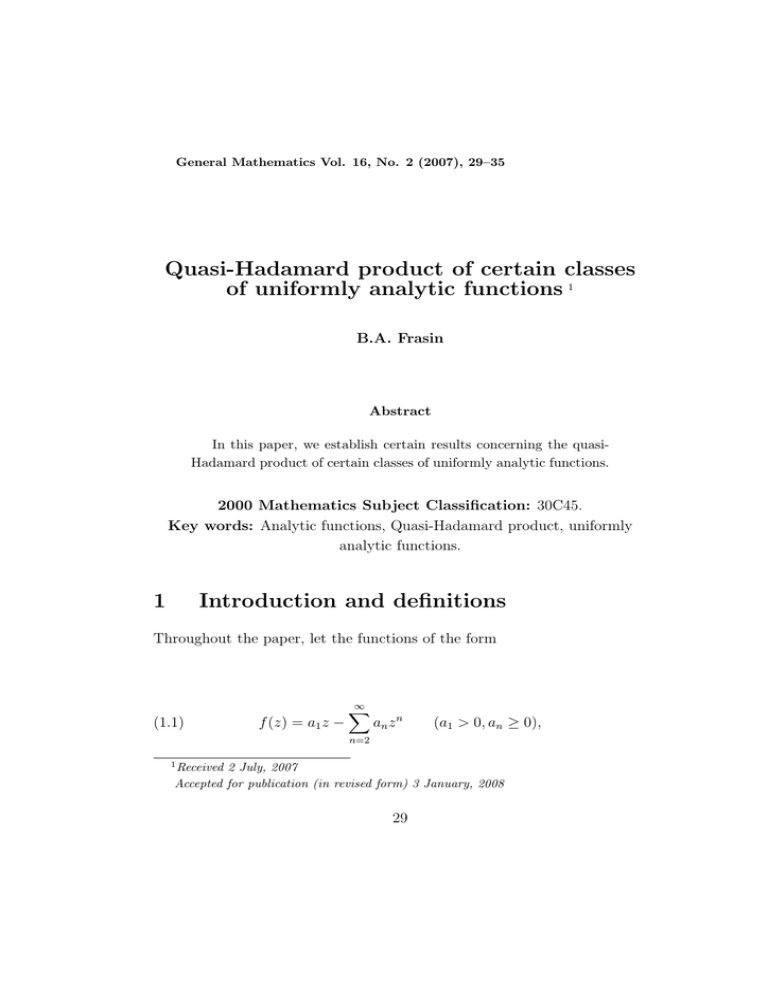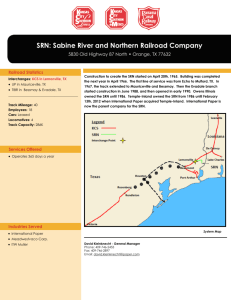Quasi-Hadamard product of certain classes of uniformly analytic functions B.A. Frasin
advertisement

General Mathematics Vol. 16, No. 2 (2007), 29–35
Quasi-Hadamard product of certain classes
of uniformly analytic functions 1
B.A. Frasin
Abstract
In this paper, we establish certain results concerning the quasiHadamard product of certain classes of uniformly analytic functions.
2000 Mathematics Subject Classification: 30C45.
Key words: Analytic functions, Quasi-Hadamard product, uniformly
analytic functions.
1
Introduction and definitions
Throughout the paper, let the functions of the form
(1.1)
f (z) = a1 z −
∞
X
an z n
(a1 > 0, an ≥ 0),
n=2
1
Received 2 July, 2007
Accepted for publication (in revised form) 3 January, 2008
29
30
(1.2)
B.A. Frasin
g(z) = b1 z −
∞
X
bn z n
(b1 > 0, bn ≥ 0),
n=2
(1.3)
fi (z) = a1,i z −
∞
X
an,i z n
(a1,i > 0, an,i ≥ 0),
bn,j z n
(b1,j > 0, bn,j ≥ 0),
n=2
and
(1.4)
gj (z) = b1,j z −
∞
X
n=2
be analytic in the open unit disc U = {z : |z| < 1} .
Let ST0 (α, k) denote the class of functions f (z) defined by (1.1) and
satisfy the condition
¯
¯ ′
½ ′ ¾
¯
¯ zf (z)
zf (z)
¯
(z ∈ U)
− 1¯¯ + α.
(1.5)
Re
≥ k¯
f (z)
f (z)
for some k (0 ≤ k < ∞)and α (0 ≤ α < 1). Also denote by U CT0 (α, k) the
class of functions f (z) defined by (1.1) and satisfy the condition
¯ ′′ ¯
½
¾
¯ zf (z) ¯
zf ′′ (z)
¯ + α.
(1.6)
Re 1 + ′
(z ∈ U)
≥ k ¯¯ ′
f (z)
f (z) ¯
for some k (0 ≤ k < ∞) and α (0 ≤ α < 1). The classes ST0 (α, k)
and U CT0 (α, k) are of special interest for it contains many well-known
classes of analytic functions. For example and when a1 = 1 the classes
ST0 (α, k) ≡ k −Sp T (α) and U CT0 (α, k) ≡ k −U CV (α) were introduced
and studied by Bharati et al.[1]. Also, the classes ST0 (0, k) ≡ k −ST and
U CT0 (0, k) ≡ k −U CV are, respectively, the subclasses of A consisting of
functions which are k- starlike and k-uniformly convex in U introduced
by Kanas and Winsiowska ([3, 4])(see also the work of Kanas and Srivastava [5], Goodman ([9, 10]), Rønning ([12, 13]), Ma and Minda [11] and
Gangadharan et al.[8]). For k = 0, the classes ST0 (α, 0) ≡ ST0∗ (α) and
Quasi-Hadamard product of certain classes of...
31
U CT0 (α, 0) ≡ C0 (α) are, respectively, the well-known classes of starlike
functions of order α (0 ≤ α < 1) and convex of order α (0 ≤ α < 1) in U
(see [14]).
Using similar arguments as given by Bharati et al.[1], one can prove
the following analogous results for functions in the classes ST0 (α, k) and
U CT0 (α, k).
A function f (z) ∈ ST0 (α, k) if and only if
(1.7)
∞
X
[n(1 + k) − (k + α)]an ≤ (1 − α)a1 ;
n=2
and f (z) ∈ U CT0 (α, k) if and only if
(1.8)
∞
X
n[n(1 + k) − (k + α)]an ≤ (1 − α)a1 .
n=2
We now introduce the following class of analytic functions which plays
an important role in the discussion that follows.
A function f (z) ∈ STm (α, k) if and only if
(1.9)
∞
X
nm [n(1 + k) − (k + α)]an ≤ (1 − α)a1 ,
n=2
where k (0 ≤ k < ∞), α (0 ≤ α < 1) and k is any fixed nonnegative real
number.
Evidently, ST1 (α, k) ≡ U CT0 (α, k) and, for m = 0, STm (α, k) is identical to ST0 (α, k). Further, STm (α, k) ⊂ STh (α, k) if m > h ≥ 0, the
containment being proper. Whence, for any positive integer m, we have the
inclusion relation
STm (α, k) ⊂ STm−1 (α, k) ⊂ . . . ⊂ ST2 (α, k) ⊂ U CT0 (α, k) ⊂ ST0 (α, k).
We note that for every nonnegative real number m, the class STm (α, k)
is nonempty as the functions of the form
f (z) = a1 z −
∞
X
n=2
(1 − α)a1
λn z n ,
+ k) − (k + α)]
nm [n(1
32
B.A. Frasin
where 0 ≤ k < ∞, 0 ≤ α < 1, a1 > 0, λn ≥ 0 and
∞
P
λn ≤ 1, satisfy the
n=2
inequality (1.9).
Let us define the quasi-Hadamard product of the functions f (z) and g(z)
by
(1.10)
f ∗ g(z) = a1 b1 z −
∞
X
an b n z n
n=2
Similarly, we can define the quasi-Hadamard product of more than two
functions.
In this paper, we establish certain results concerning the quasi-Hadamard
product of functions in the classes STm (α, k), ST0 (α, k) and U CT0 (α, k)
analogous to the results Kumar ([6, 7])( see also [2]).
2
Main Theorem
Theorem. Let the functions fi (z) defined by (1.3) be in the class U CT0 (α, k)
for every i = 1, 2, . . . , r; and let the functions gi (z) defined by (1.4) be in the
class ST0 (α, k) for every j = 1, 2, . . . , s. Then the quasi-Hadamard product
f1 ∗ f2 ∗ . . . ∗ fr ∗ g1 ∗ g2 ∗ . . . ∗ gs (z) belongs to the class ST2r+s−1 (α, k).
Proof. Let h(z) := f1 ∗ f2 ∗ . . . ∗ fr ∗ g1 ∗ g2 ∗ . . . ∗ gs (z), then
)
( r
)
( r
s
∞
s
Y
X
Y
Y
Y
bn,j z n .
an,i
b1,j z −
(2.11)
h(z) =
a1,i
i=1
n=2
j=1
i=1
j=1
We need to show that
"
( r
)#
∞
s
X
Y
Y
n2r+s−1 {n(1 + k) − (k + α)}
an,i
bn,j
n=2
(2.12)
i=1
≤ (1 − α)
(
r
Y
i=1
a1,i
s
Y
j=1
b1,j
)
j=1
.
Quasi-Hadamard product of certain classes of...
33
Since fi (z) ∈ U CT0 (α, k), we have
∞
X
(2.13)
n[n(1 + k) − (k + α)]an,i ≤ (1 − α)a1,i
n=2
for every i = 1, 2, . . . , r. Therefore,
¸
·
1−α
a1,i
an,i ≤
n[n(1 + k) − (k + α)]
which implies that
an,i ≤ n−2 a1,i
(2.14)
for every i = 1, 2, . . . , r. Similarly, for gj (z) ∈ ST0 (α, k), we have
∞
X
(2.15)
[n(1 + k) − (k + α)]bn,j ≤ (1 − α)b1,j .
n=2
for every j = 1, 2, . . . , s. Hence we obtain
bn,j ≤ n−1 b1,j
(2.16)
for every j = 1, 2, . . . , s.
Using (2.14) for i = 1, 2, . . . , r, (2.16) for j = 1, 2, . . . , s − 1, and (2.15)
for j = s , we obtain
"
( r
)#
∞
s
X
Y
Y
n2r+s−1 [n(1 + k) − (k + α)]
an,i
bn,j
n=2
≤
∞
X
n=2
=
"
i=1
n2r+s−1 [n(1 + k) − (k + α)]bn,s
̰
X
[n(1 + k) − (k + α)]bn,s
n=2
≤ (1 − α)
!Ã r
Y
i=1
(
r
Y
i=1
a1,i
s
Y
j=1
b1,j
)
.
j=1
(
n−2r n−(s−1)
a1,i
à r
Y
i=1
s−1
Y
j=1
b1,j
!
a1,i
s−1
Y
j=1
b1,j
!)#
34
B.A. Frasin
Hence h(z) ∈ ST2r+s−1 (α, k).
Note that we can prove the above theorem by using using (2.14) for
i = 1, 2, . . . , r − 1, (2.16) for j = 1, 2, . . . , s, and (2.13) for i = r.
Taking into account the quasi-Hadamard product functions f1 (z), f2 (z),
. . . , fr (z) only, in the proof of the above theorem, and using (2.14) for
i = 1, 2, . . . , r − 1, and (2.13) for i = r, we obtain
Corollary 1. Let the functions fi (z) defined by (1.3) be in the class
U CT0 (α, k) for every i = 1, 2, . . . , r. Then the quasi-Hadamard product
f1 ∗ f2 ∗ . . . ∗ fr belongs to the class ST2r−1 (α, k).
Next, taking into account the quasi-Hadamard product functions g1 (z),
g2 (z), . . . , gr (z) only, in the proof of the above theorem, and using (2.16) for
j = 1, 2, . . . , s − 1, and (2.15) for j = s , we obtain
Corollary 2. Let the functions gi (z) defined by (1.4) be in the class
ST0 (α, k) for every j = 1, 2, . . . , s. Then the quasi-Hadamard product g1 ∗
g2 ∗ . . . ∗ gs (z) belongs to the class STs−1 (α, k).
References
[1] R. Bharati, R. Parvatham and A. Swaminathan, On Subclasses of uniformly convex functions and corresponding class of starlike functions,
Tamkang J. Math., 28 (1997), 17-32.
[2] E. W. Darwish, The Quasi-Hadamard product of certain starlike and
convex functions, Appl. Math. Lett. 20 (2007), 692-695.
[3] S. Kanas and A. Wisniowska, Conic regions and k- uniform convexity,
J. Comput. Appl. Math. 105 (1999), 327-336.
[4] S. Kanas and A. Wisniowska, Conic regions and k- starlike functions,
Rev. Roumaine Math. Pures Appl., 45(4)(2000), 647-657.
[5] S. Kanas and H.M. Srivastava, Linear operators associated with kuniformly convex functions, Integral Transform. Spec. Funct. 9, 121132, (2000).
Quasi-Hadamard product of certain classes of...
35
[6] V. Kumar, Hadamard product of certain starlike functions, J. Math.
Anal. Appl. 110(1985), 425-428.
[7] V. Kumar, Quasi-Hadamard product of certain univalent, J. Math.
Anal. Appl. 126(1987), 70-77.
[8] A. Gangadharan, T.N. Shanmugan and H.M. Srivastava, Generalized
Hypergeometric functions associated with k-uniformly convex functions,
Comput. Math. App. 44 (2002), 1515-1526.
[9] A.W. Goodman, On uniformly convex functions, Ann. Polon. Math.
56, 87-92, (1991).
[10] A.W. Goodman, On uniformly starlike functions, J. Math. Anal. Appl.
155, 364-370, (1991).
[11] W.C. Ma and D. Minda, Uniformly convex functions, Ann. Polon.
Math. 57 (1992), no.2, 165-175.
[12] F. Rønning, Uniformly convex functions and a corresponding class of
starlike functions, Proc. Amer. Math. Soc. 118 (1993), no.1, 189-196.
[13] F. Rønning, On starlike functions associated with parabolic regions,
Ann Univ. Mariae Curie-Sklodowska Sect. A 45 (1991), 117-122.
[14] H. Silverman, Extreme points of univalent functions with two fixed
points, Trans. Amer. Math. Soc. 219 (1976), 385-397.
Department of Mathematics,
Al al-Bayt University,
P.O. Box: 130095
Mafraq, Jordan.
E-mail address: bafrasin@yahoo.com.




